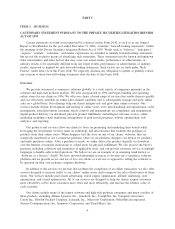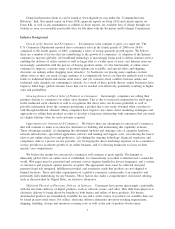Digital River 2006 Annual Report Download - page 20
Download and view the complete annual report
Please find page 20 of the 2006 Digital River annual report below. You can navigate through the pages in the report by either clicking on the pages listed below, or by using the keyword search tool below to find specific information within the annual report.partnerships. Prior to 1995, Mr. Donnelly served as an investment analyst for Marshall Financial Group, a
merchant banking company, Chief Financial Officer of Medical Documentation Systems, Inc., a medical
software company, and Controller of Staats International, Inc., a defense subcontractor.
ITEM 1A. RISK FACTORS
The risks described below are not the only ones facing our company. Additional risks not presently known
to us or that we currently deem immaterial also may impair our business operations. Our business, financial
condition or results of operations could be materially adversely affected by any of these risks and the value of
our common stock could decline due to any of these risks. This annual report also contains forward-looking
statements that involve risks and uncertainties. Our actual results could differ materially from those
anticipated in these forward-looking statements as a result of certain factors, including the risks faced by us
described below and elsewhere in this report.
A loss of any client that accounts for a large portion of our revenue would cause our revenue to decline.
Sales of products for one software publisher client, Symantec Corporation, accounted for approximately
30.2% of our revenue in 2006. In addition, revenues derived from proprietary Digital River services sold to
Symantec end-users and sales of Symantec products through our oneNetwork retail and affiliate channel
together accounted for approximately 16.6% of total Digital River revenue. In addition, a limited number of
other software and physical goods clients contribute a large portion of our annual revenue. Contracts with our
clients are generally one or two years in length. If any one of these key contracts is not renewed or otherwise
terminates, or if revenues from these clients decline for any other reason (such as competitive developments),
our revenue would decline and our ability to sustain profitability would be impaired. If our contract with
Symantec is not renewed or otherwise terminated, or if revenues from Symantec and Symantec-related services
decline for any other reason, our revenue and our ability to sustain profitability could be materially adversely
impaired. It is important to our ongoing success that we maintain our key client relationships and, at the same
time, develop new client relationships.
We have a limited profitable operating history.
Our limited profitable operating history, which we first achieved in the quarter ended September 30,
2002, makes it difficult to evaluate our ability to sustain profitability in the future. The success of our business
model depends upon our success in generating sufficient transaction and service fees from the use of our
e-commerce solutions by existing and future clients. Accordingly, we must maintain our existing relationships
and develop new relationships with software publishers, online retailers and physical goods clients. To achieve
this goal, we intend to continue to expend significant financial and management resources on the development
of additional services, sales and marketing, improved technology and expanded operations. If we are unable to
maintain existing, and develop new, client relationships, we will not generate a profitable return on our
investments and we will be unable to gain meaningful market share to justify those investments. Further, we
may be unable to sustain profitability if our revenues decrease or increase at a slower rate than expected, or if
operating expenses exceed our expectations and cannot be adjusted to compensate for lower than expected
revenues.
Failure to properly manage and sustain our expansion efforts could strain our management and other
resources.
Through acquisitions and organic growth, we are rapidly and significantly expanding our operations, both
domestically and internationally. We will continue to expand further to pursue growth of our service offerings
and customer base. This expansion increases the complexity of our business and places a significant strain on
our management, operations, technical performance, financial resources, and internal financial control and
reporting functions, and there can be no assurance that we will be able to manage it effectively. Our personnel,
systems, procedures and controls may not be adequate to effectively manage our future operations, especially
as we employ personnel in multiple domestic and international locations. We may not be able to hire, train,
retain and manage the personnel required to address our growth. Failure to effectively manage our growth
16
























